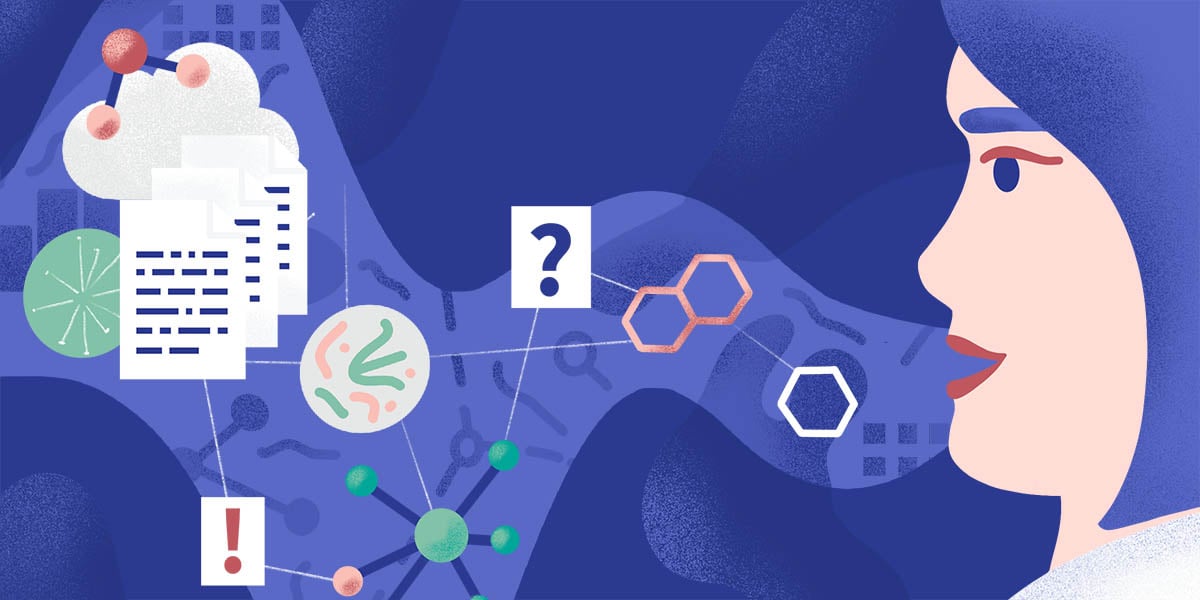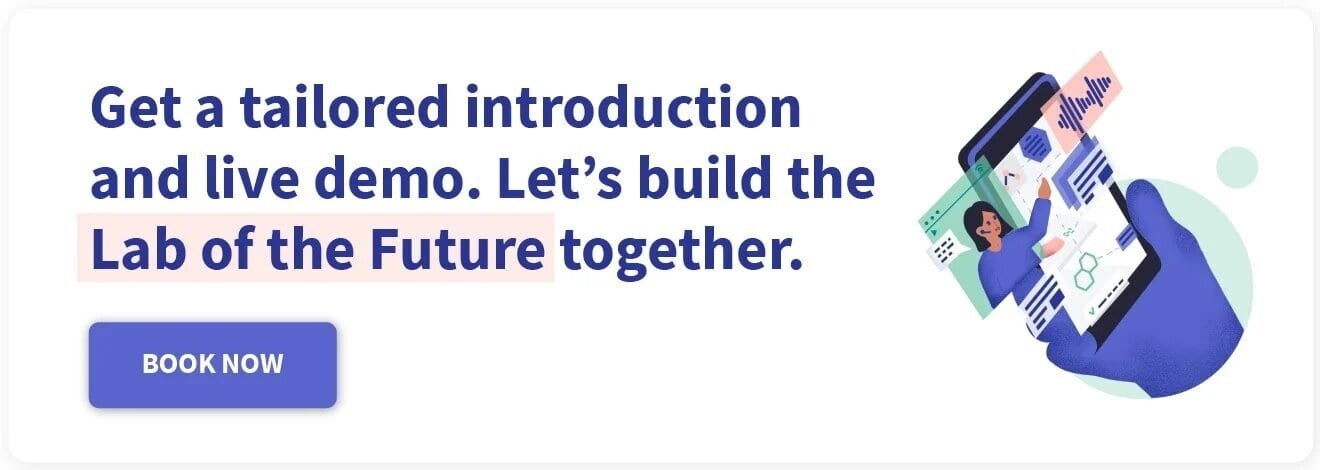Research scientists spend 50-80% of their time at the bench with no easy way to record data or access information. New voice-powered digital tools solve this problem by connecting scientists with information at the point of experimentation.
Hands-free control of software and lab equipment allows scientists to simultaneously work on their experiments while recording results or finding quick answers to scientific questions. Voice tools will empower bench scientists by streamlining their workflows and taking care of mundane tasks like setting timers, managing inventory and ordering reagents.
Moreover, voice-powered data management will make labs more efficient by reducing data entry errors, eliminating interruptions, integrating information and improving experimental efficiency and reproducibility.
Easy Integration to lab technology
Voice-activated tools can easily integrate into current lab informatics strategies and provide scientists with a mobile, user-friendly interface. These tools will help IT professionals build the interconnected Smart Lab of the Future: compliant, secure and audit-ready. Within the next few years, voice-powered lab informatics could allow scientists to control experiments, manage lab equipment, record results and access data from anywhere in the world.
Real-time Documentation of Results and Experimental Parameters
Many scientists work on multiple experiments a day, often using hazardous chemicals or sensitive reagents such as cultured cells. In these conditions, researchers must stop an experiment to record data or check information, for example to look up a dilution from a previous experiment.
Voice-powered digital assistants can connect with lab machines and automatically record experimental parameters such as the weight or volume of reagents, incubation temperature or assay results. Scientists can also record voice notes simply by speaking to a mobile device.
Real-time, hands-free documentation speeds up workflow and eliminates manual transcription errors. It allows scientists to focus on their experiments without the distraction of trying to take notes. By making documentation easier, voice-powered tools improve the quality of lab documents. Incomplete or missing data, particularly on experimental conditions, is a major source of error in research labs. Voice-activated informatics help eliminate these errors.
“We founded LabTwin because, after working directly with scientists for over ten years, I saw a real need for better automation, data access and capture while working at the bench. It is difficult and time-consuming for scientists to manually look up information or document all of the details required when they are working on four to five experiments at a time. LabTwin’s digital assistant leverages AI and voice-recognition technology to minimize errors, streamline productivity and improve reproducibility of scientific discoveries.”
Steffen Gloth, Co-Founder and Head of Operations, LabTwin
On-Demand Access to Scientific Data
Voice-powered data management flows both ways. As well as recording data, scientists can also use digital assistants to instantly access information from published databases and internal lab records. New generation digital assistants will scan and collate information from many sources to provide scientists with up-to-date, scientifically accurate answers to their queries.
“Our goal at LabTwin is to give scientists access to information at the point of experimentation and allow them to document their findings without effort. A liveable and interactive process.”
Magdalena Paluch, Co-Founder and CEO, LabTwin

For example, if a scientist asks, “How should I culture CHO cells?”, a voice-activated digital assistant will provide a validated protocol.
Likewise, if a researcher asks, “Which blocking agent did I use on the Western blot last Thursday?”, the digital lab assistant will be able to scan internal lab records and answer the question.
This intuitive real-time access to scientific information will reduce distractions and allow scientists to continue uninterrupted experimental work.
Interactive Protocols
It is still very common for scientists to print out protocols and take them into the lab. Then if researchers make any changes, or notice any protocol deviations, they must stop work and remove their gloves to note these down.
Voice-powered digital lab assistants replace these static paper documents with interactive protocols. Digital assistants can guide scientists step-by-step through experimental protocols, communicate directly with lab machines and check for human error. For example, if a connected balance is not zeroed before use, a digital lab assistant will not let the protocol proceed. This prevents unintentional and unrecorded experimental errors and improves experimental efficiency and reproducibility.
“Using LabTwin, we captured more important details e.g. batch numbers, change of protocol, additional steps, unsuccessful experiments. This helps us understand why an experiment didn’t work.”
Scientist at a top pharma company, a LabTwin user.
Digital assistants also allow scientists to make voice annotations and protocol updates in real-time, so this valuable information is not lost. Voice-powered assistants can track work with automatic time stamps to protect intellectual property and comply with internal and external regulations. Digital lab assistants make it easy to perform organization-wide audits.
“Simply put, LabTwin takes an organization’s commitment to quality to whole new levels, without being obtrusive to the end user. We can stringently guide a scientist through a specific SOP, regardless of their knowledge of the original document, so that compliance is not only more efficient for the scientist, but a mandatory component of their workflow. This provides a further audit insurance policy as their actions during these workflows are recorded in real time.”
John Egerton, Head of Sales, LabTwin
Integration of Lab Data
Another major benefit offered by voice-activated digital lab assistants is data integration. Scientific data comes in many forms, from many different sources. This means scientists often have to waste time manually moving content between devices and harmonizing units of measurement and other data parameters.
Digital assistants will potentially remove that source of error by automatically collating and storing lab data in one central, secure and compliant place. This removes data silos inside labs, preventing lost data and unnecessary experimental duplication. Data becomes instantly accessible from anywhere in the lab. Researchers can quickly and easily create reports to share with colleagues and managers can easily monitor lab work.
“Our software makes scientific work automatically reproducible. We want to change the culture so that people don’t have to go to their desk at the end of the day and spend time trying to remember what happened to document it. Magdalena Paluch, Co-Founder and CEO, LabTwin
Central Control of Lab Informatics and Machines
As lab tools continue to evolve, lab informatics solutions will be able to connect with more lab machines, allowing scientists to control complicated experiments remotely and even set experiments to be performed overnight. This ‘Smart Lab’ vision is rapidly becoming reality as life science companies build connectivity into their products.
Integrated, automated lab tools will reduce experimental downtime and eliminate sources of human error. It will free up researchers to concentrate on experimental design and data analysis.
“Operating machines and collecting data via voice can eliminate the problem of a ‘data graveyard’. With LabTwin’s API, integrated instruments can directly push data to LabTwin. Researchers and managers can easily access all data within in a single platform.” Guru Singh, Head of Growth, LabTwin

Inventory Management
Tracking large biological sample inventories is a significant lab informatics challenge. Companies often store samples in a central repository and then distribute these samples to different scientists to perform a range of assays. It can be very difficult to track samples in real time. With voice-powered, integrated lab informatics, scientists can annotate sample use in real time as they work, and this information can be automatically and instantly available to the whole team.
“With voice, scientists can conveniently capture data at the source in real time, adhere to their SOPs, and maintain the audit trail of inventory use. Managers and biorepository staff can easily see where and when samples were used.”
Denis Ödzemir, Head of Customer Success, LabTwin
Lab Supply management
As scientists work, they often notice if stocks of a chemical or reagent are running low. However, if their hands are busy with an experiment, they may forget to note ordering requirements. Voice-powered digital assistants can enable scientists to order reagents while running experiments.
With voice-powered digital assistants, researchers can also set timers or reminders, and check calendar reminders. The power of voice means these tasks can be performed without interrupting experiments.
“Our focus is on solving problems faced by scientists and filling gaps in their day-to-day workflow. LabTwin works as a digital twin, empowering researchers by connecting them with their all of their data, all of the time.”
Guru Singh, Head of Growth, LabTwin
The Smart Lab of the Future
New digital assistants complement existing technology and form an integral part of the Smart Lab of the Future. As lab tools evolve, we are coming closer to being able to create an automated, integrated, hands-free lab environment. Digital advances such as voice-activated technology and machine learning will put informatics at the forefront in supporting scientists, reducing error rates and improving research efficiency.
“Digital labs will have an effortless flow of information using tools like LabTwin’s digital assistant, which gives scientists easy access to information no matter where they are working.” Jonas Kulessa, Head of Engineering, LabTwin.
Contact us for more information on how LabTwin can help you build your Smart Lab of the Future.



